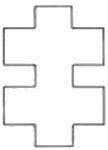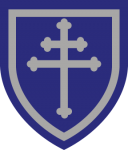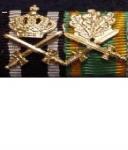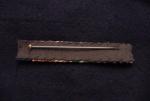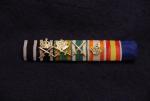-
Posts
638 -
Joined
-
Last visited
Content Type
Profiles
Forums
Blogs
Gallery
Events
Store
Everything posted by ostprussenmann_new
-
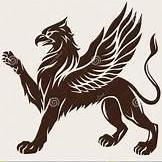
Lengths of US Ribbon
ostprussenmann_new replied to Marco Gollino's topic in United States of America
What about trying Quaterdeck militaria out of Australia? For some reason this guy is allowed to make Medal of Honor Replicas. I am sorry to say, but unlike our European friends, Most US military medals are easy to come by and are cheap to get. One suggestion that i have, if you really want to mount yur specifics is to buy a current issued medal that you have and destroy it so you can mount yours. Or how about just buying the medals how you would like them mounted and keep your originals (if they are old) in the safe. Try medals of america. They make the special flat ribbon bars and might have length of ribbon for sale. I have never heard this for US medals because they are so cheap to get. The next thing that you need to figure out is if you want the US Army/Air Force style of mounting or the US Navy/Marine style of mounting. They are different. I am speaking from experience because I am a member of the US Military Forces myself. ostprussenmann. -
To anyone out there. I recieved my Regimental History for this Regiment. I have already provided requested information to fellow member MHunter. If anyone else needs anything or has any questions, please let me know. Matt requested information for Richard Nesselhauf. This book has a complete Rangliste for all officers. I am going to have to say that the Rgiment lost alot of officers. It is quite amazing. In regards to regular Soldiers, there is no Ehrenstaffel, but you have to dig in the book to find the specific dates when Soldiers were killed throughout the book. ostprussenmann
-
Fellow Members I beleive that it is our duty as historians and collectors to preserve history for future generations. There is a database, that has been around for sometime now, that is attempting to document Iron Cross winners. You have heard of it or have already registered so this posting is not an insult to your intelligence. I have placed my family members and I am getting ready to post my Soldier grouping information on it. Most of us have an Iron Cross in our collections, no matter what era of German History. Some of us have Death Cards or larger groupings with an Iron Cross in that that holds a name. I think that this website is a great start and way to document their stories; besides on GMIC. If you get a chance and have some time, please register and tell the story of your important piece of history. The more places that we document history, the more accessible it is for everyone to share. anybody's thoughts? Ostprussenmann.
-

Bundesrepublik Einsatzmedaille Gefecht
ostprussenmann_new replied to Elvis's topic in Germany: Post 1945: Bundesrepublik & DDR
I would say this is like the US Army's Combat Action Badge or Combat Infantry Badge. It's for getting shot at I am am assuming. ostprussenmann -
Thanks for letting us know. I understadn that after "Band of Brothers" his family and himself wanted to keep to their private lives, which he had the right to do. Any more BOB guys that have recently passed? What about "Wild Bill" Guenuere?
-
I definitley agree with your last statement. I would not be suprised if Veterans, not nobility, sold off or melted down their awards for Silver and gold content to just provide themselves and their families with food to eat. That might be a contributing factor, besides certain principalites required return of ward upon death, why certain medal bars are missing certain medals off of them. ostprussenmann
-
This is an interesting topic, because I have always wondered the same. In the Case of Colonial Service, wouldn't that be true during the War 1914-1918? Here is an example: If a Soldier completed his mandatory Active Service from 1910-1912, then was placed in the Reserve from 1912-1914, then served in the Army during the War from 1914-1918 and ended up as a Gefreiter, wouldn't that Soldier be intitled to either a 12-year LS medal or at least a 9 year LS medal? Where he was entitled to it or not, an officer had to award it to him anyways. If that officer was lazy, he might not even recieve a LS medal. Am I correct in my assumptions or not? ostprussenmann
-
The 79th Infantry Division (79. Infanterie-Division) was an infantry division of the German Wehrmacht during World War II. Creation and Early History The 79th Infantry Division began mobilization on March 1, 1939 as a part of the second German "wave" system (2. Welle) of mobilization. Welle was the German designation for groups of infantry divisions raised at approximately the same time, with approximately the same type of organization,equipment, personnel and training. Raised from Rheinlanders in German Military District (Wehrkreis) XII, headquartered in Wiesbaden,the home station of the 79th was Koblenz. It was designated as a Division on August 26, 1939. Assigned to the French-German border in the Saar region, the 79th trained and worked on the West Wall. The Division saw action against the French on the Saar Front on May 10, 1940 when they were a part of the invasion forces. In June, the division participated in attacks on the Maginot Line and the capture of Epinal. The Cross of Lorraine (Lothringer Kreuz) was designated as the symbol. Unteroffizier Werner Psaar stated that since the division's first combat was mainly in the Lorraine region, this is what led to the symbol. From June 1940 until April 1941, the division was on occupation duty and trained for Operation Sea Lion. The 79th was relocated to Klagenfurt in April 1941 but was too late for the invasion of Yugoslavia. Barbarossa It was assigned to Heeresgruppe Süd for Operation Barbarossa on June 26, 1941. From June 1941 until September 1942 the 79th fought in southern Russia at Korosten, Lutsk, Rovno, Piryatin, and Akhtyrka, Kharkov, Voronezh, Izyum and Kalack before being sent in October 1942 to the Battle of Stalingrad. Stalingrad The Sixth Army, including the 79th, began its attack on Stalingrad on October 17, 1942. The fighting in the Red October Tractor Factory was fiercely fought, hall by hall. When the Soviet Offensive started on November 19, 1942, the 79th was one of the units trapped in the "kessel" when they were surrounded on November 24. The Sixth Army surrendered on January 31, 1943. The division staff, including the Ia (Operations Officer) Oberst Hans Schwanbeck, were flown out of Stalingrad on January 8 - 9, 1943. This evacuation is still an issue with surviving veterans of the 79th. Most men were taken into Soviet captivity including Generalleutnant Alexander von Daniels, the commander. Second Life The 79th was quickly raised again by the surviving staff officers. On January 12, 1943, from remnants of other German units near Rostov. The division then took part in operations in the Novocherkassk area until relieved on March 13, 1943. They refitted in the Volnovakha area and in April 1943, returned to battle. They fought a number of defensive actions before reaching the Kuban Bridgehead in August 1943. The division was evacuated to the Ukraine and continued a slow movement west for almost a year. Romania 1944 found the 79th in Romania as a part of IV Korps, 6. Armee. By August, the 79th was one of the divisions attempting to hold the city of Jassy. On August 23, 1944, with Romania capitulated, 79th was once again encircled and virtually annihilated near Chitcani, Romania on the Berlad River. Less than 1,000 soldiers managed to escape. Generalleutnant Friedrich Weinknecht became the second commander of the 79th Infantry Division to be captured by the Soviets. Third Life - Volksgrenadier On October 27, 1944, the division was raised again outside of the Welle system, this time in West Prussia and now as the 79th Volksgrenadier Division (79. Volks-Grenadier-Division). It had only ten percent combat veterans and was largely made up by absorbing the 586th Volksgrenadier Division (Katzbach). On December 11, 1944, the 79th Volsgrenadier Division was assigned to 7. Armee a reserve force near Bitburg, Germany. Though at half strength, the 79th was to take part in Operation Herbstnebel. Luxembourg On December 21, 1944, the 79th VG towards its assembly area near Diekirch, Luxembourg. On December 24, 1944, the Volksgrenadiers in conjunction with the Führer Grenadier Brigade, launched a series of attacks against the Blue Ridge Division, the 80th Infantry Division (United States). The objective was to seize the town of Heiderscheid, a strategic bridge crossing along the Sure River. Both units suffered very heavy losses, particularly when on December 26 most of the 79th VG artillery and FGB armor was destroyed by American fighter bombers. The 79th VG begin falling back, unable to hold against the US 80th Infantry Division, towards the town of Baunscheid, to hold another strategic bridgehead there. 1945 After Heavy fighting continued in to January 1945, the Division fell to U.S. forces at Heidelberg and Darmstadt. Remains of the 79th fought in the vicinity of Rothenburg ob der Tauber under the name Battle Group (Kampfgruppe) "Hummel" in mid-April. This last organized unit of the 79th Volksgrenadier Division surrendered to US Forces on April 14, 1945. Grenadiers of the 79th Volksgrenadier Division fought small unit actions in the Alps. Commanders 79th Infantry Division (March 1939 - March 1945) General der Infanterie Karl Strecker March 1939 - January 1942 Generalleutnant Richard Graf von Schwerin January 1942 - August 1943 Generalmajor Heinrich Kreipe August 1943 - October 1943 Oberst von Aulock October 1943 Generalleutnant Friedrich-August Weinknecht October 1943 - August 29, 1944 (POW) Generalmajor Erich Weber 1944 Oberst Reinherr 1945 Oberst Hummel 1945 Oberstleutnant von Hobe 1945 Oberst Reymann 1945 Oberst Seeher 1945 Karl Strecker, Generalleutnant, Commanding Officer, October 26, 1941Friedrich Weinknecht, Generalleutnant, Commanding Officer, July 15, 1944208 Regiment Günter Goebel, Hauptmann, Fhr. einer Kampfgr. G.R. 208, January 18, 1943 with Oak LeavesRichard Wolf, Oberstleutnant, Kommandeur G.R. 208, April 19, 1945 with Oak LeavesFritz Müller, Oberstleutnant Kommandeur G.R. 208, May 14, 1944 with Oak LeavesJakob Roth, Unteroffizier, Zugführer 2./G.R. 208, June 4, 1944Gustav Woszella, Leutnant, Führer 8./G.R. 208, July 4, 1944212 Regiment Richard Eichler, Oberstleutnant, Kommandeur G.R. 212, January 20, 1943Volkhard Eitner, Hauptmann, Kommandeur I./G.R. 212, June 10, 1943Robert Nittler, Oberleutnant, 3./G.R. 212, January 20, 1943226 Regiment Andreas von Aulock, Oberst, Kommandeur G.R. 226, August 16, 1944 with Oak LeavesFritz Krück, Oberleutnant Führer II./G.R. 226, March 5, 1945Karl-Willi Lumpp, Oberleutnant, d. R. Führer 3./G.R.226, July 18, 1943Hans-Hermann Möckel, Hauptmann, Führer Kampfgruppe, April 17, 1945179 Panzerabwehr-Abteilung Josef Röder, Obergefreiter, January 20, 1943Orders of Battle Order of Battle 1939 Infanterie-Regiment 208Infanterie-Regiment 212Infanterie-Regiment 226Artillerie-Regiment 179Panzerabwehr-Abteilung 179Pionier-Battalion 179Aufklärungs-Abteilung 179Infanterie-Divisions-Nachrichten-Abteilung 179Infanterie-Divisions-Nachschubtruppen 179Order of Battle 1944 Grenadier-Regiment 208Grenadier-Regiment 212Grenadier-Regiment 226Divisions-Füsilier-Battalion 79Artillerie-Regiment 179Panzerjäger-Abteilung 179Pionier-Battalion 179Feldersatz-Battalion 179Infanterie-Divisions-Nachrichten-Abteilung 179Infanterie-Divisions-Nachschubtruppen 179Trivia The Cross of Lorraine was used as a divisional insignia by both the German 79th Infantry Division and its American counterpart. Printed references Quarrie, Bruce The Ardennes Offensive, I ARMEE & VII ARMEE (Order of Battle series book), Osprey Publishing Group, London, UK. 2001. ISBN 1 85532 913 1Hans Sänger Die 79. Infanterie-Division. 1939, ISBN 10 3895552135Unteroffizier Werner Psaar, Source: "Wiesbadener Soldatenkalender 1943" Rud. Bechtold & Comp. , Wiesbaden
-
Was this Infanterie-Regiment von Grolman (1. Posensches) Nr. 18 or Kgl. Bayer. 18. Infanterie-Regiment Prinz Ludwig Ferdinand ? I would assume von Grolman since most of his awards are Prussian. If it is von Grolman, I can provide some more infomration once my Regimental History of the unit arrives from Germany. I possibly can find what Company, etc. that he was assigned to during the War. Jason
-

Prins Dschero Khan - US special forces?
ostprussenmann_new replied to Herr General's topic in United States of America
As for the Silver Star (Red white, Blue next to BSM w/ V), His name would be online for Recipiants in the US. The Halo wings are BS and the UN Medal with 1960 Device is wrong. The 1960 device goes on the Green and White Ribbon. This guy is one of the worst BSers that I have seen.


